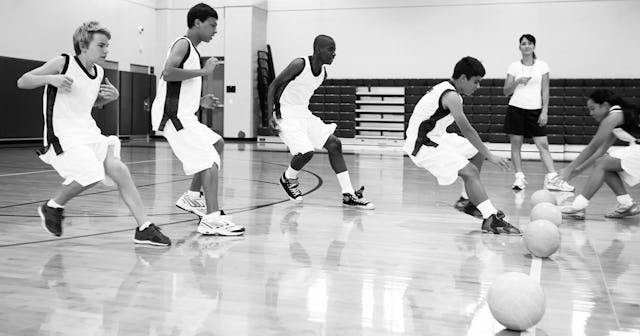Dodgeball Really Is The Stuff Of Childhood Nightmares -- Let's Play This Instead

It’s the stuff of childhood nightmares. A ball goes whizzing past your head. Another one narrowly misses your leg. Another one, and then another one, and then another one are being hurled at you and there’s no escape. You jump out of the path of one, only to be struck in the abdomen with another.
As if the sting of a rubber ball nailing you in the stomach isn’t enough to knock the wind out of you, the sting of defeat certainly will. Because you’re out. You’ve lost. You’re done.
This is dodgeball, or as some call it, “slaughterball.” And it truly is the game of childhood nightmares. At least for kids like me.
I was the kid typically picked last for most gym class activities. I was awkward and uncoordinated. And while I wouldn’t call myself unathletic (I actually went on to swim competitively at a Division 1 university), I was definitely what you’d call unskilled at traditional team sports. Sports like soccer and basketball were tolerable at best, games like dodgeball were terrifying.
Nonetheless, dodgeball was the mainstay of many 1980s PE classes – and it continues today. But some folks are calling for an end to it once and for all.
“People say [dodgeball] is being used as an outlet for aggression or catharsis,” Joy Butler, a professor who studies pedagogy and curriculum development at University of British Columbia, told the Washington Post in a phone interview. “I suspect that [PE class] is where they’re learning that.”
According to the Washington Post, a team of Canadian researchers calls dodgeball a game of “oppression” and “teaches students to dehumanize and harm their peers.” The researchers interviewed middle school students, asking a variety of broad questions about physical education class, and noticed a recurring theme emerging – students hated dodgeball. When they probed further on why students hated the game, they saw common themes associated with oppression.
“The message is that it’s okay to hurt or dehumanize the ‘other,’” Butler told the Post. “The competition is about annihilating one’s opponent, and the true definition of competition is between two evenly matched teams. Well, kids stack their teams, and they really enjoy beating the other team. What’s the enjoyment of that?”
Of course, not everyone hates dodgeball. Who hasn’t laughed hysterically at the movie Dodgeball? Many kids today still play it at recess or at indoor trampoline parks, laughing and having a great time. But there is a better – kinder – way to play than the “kill or be killed” approach of dodgeball. Because chances are if you don’t hate it – or maybe even like it – you’re not one of those people getting pelted with speeding rubber balls at your head; you might be the one doing the pelting.
Washington Post/Facebook
“Researchers observed the more athletic and authoritative students in the class established rules and practices without input from other students, including creating their own teams, which allowed them to gang up on other students,” wrote the Washington Post.
The researchers are calling on PE teachers to get rid of dodgeball from their curriculum, and some PE teachers agree.
Washington Post/Facebook
Instead of dodgeball, some schools are playing gaga ball in PE class. Gaga ball is considered “a kinder gentler version of dodge ball,” because the game is played with a soft foam ball and hits to your opponent can only be made below the knees. Some experts are calling gaga ball “the great playground equalizer,” because it doesn’t require a strong throwing arm, super fast legs, or advanced hand-eye coordination. It’s a game that almost anybody can play — and enjoy.
Here’s the thing: Whether you love or hate dodgeball, it doesn’t actually teach anything. If you struggle with throwing or catching the ball, you aren’t given the time or space to actually learn that skill because you’re too busy trying to just survive. This isn’t about injury either; all sports come with physical risks. And this isn’t about being all helicopter-y or making things “too safe” for kids. This is about the tactics used, how the game is approached, the lessons reinforced, and whether it should even be part of school-endorsed learning.
After all, as Butler said, “[Physical education class] should be an arena where teachers are helping [students] control their aggression and move on instead of expressing themselves through anger.”
We are Scary Mommies, millions of unique women, united by motherhood. We are scary, and we are proud. But Scary Mommies are more than “just” mothers; we are partners (and ex-partners,) daughters, sisters, friends… and we need a space to talk about things other than the kids. So check out our Scary Mommy It’s Personal Facebook page. And if your kids are out of diapers and daycare, our Scary Mommy Tweens & Teens Facebook pageis here to help parents survive the tween and teen years (aka, the scariest of them all.)
This article was originally published on